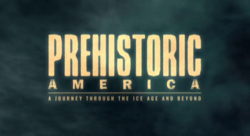Wild New World
| Wild New World | |
|---|---|
 Series title card from US broadcast | |
| Genre | Nature documentary |
| Narrated by | Jack Fortune |
| Composer | Barnaby Taylor |
| Country of origin | United Kingdom |
| Original language | English |
| No. of episodes | 6 |
| Production | |
| Executive producer | Neil Nightingale |
| Producer | Miles Barton |
| Running time | 50 minutes |
| Production companies | BBC Natural History Unit Discovery Channel |
| Original release | |
| Network | BBC Two |
| Release | 3 October – 7 November 2002 |
Wild New World, also known as Prehistoric America, is a six-part BBC documentary series about Ice Age America. It was first transmitted in the UK on BBC Two from 3 October to 7 November 2002. Like several other BBC programmes, it contains both computer graphics and real life animals. Occasionally, footage of non-American counterparts of the extinct North American beasts (like the American lion and the giant American cheetah) are used in juxtaposition with footage of native American animals, like the pronghorn.
Wild New World was co-produced by the BBC Natural History Unit and Discovery Channel. The music was composed by Barnaby Taylor and performed by the BBC Concert Orchestra. The series was narrated by Jack Fortune and produced by Miles Barton.
The series forms part of the Natural History Unit's Continents strand. It was preceded by Wild Africa in 2001 and followed by Wild Down Under in 2003.
Episodes
Each of the episode consists with the prehistory and wildlife of a particular region in the United States, except for final episode which is about various modern American animals.
| Episode | Title | Original air date | |
|---|---|---|---|
| 1 | "Land of the Mammoth" | 3 October 2002[1] | |
|
Preserved in the frozen soil of Alaska are clues to an unknown land, where muskoxen and wild horses roarmed alongside woolly mammoths. Enormous American lions harried the families of mammoths, formidable in the defence of their young. The lion were more successful at hunting at bison in the snow but they were no match for the giant short-faced bear.
| |||
| 2 | "Canyonlands" | 10 October 2002[2] | |
|
The first people to experience the splendours of the Grand Canyon would have seen a much greener, richer land. Today it is cougar country but then bizzare ground sloths sheltered in the caves and browsed in the canyons alongside Columbian mammoths. Camels were on the menu for both the first people and the impressive sabre-tooth cat, (Smilodon).
| |||
| 3 | "Ice Age Oasis" | 17 October 2002[3] | |
|
America's Deep South is today a haven for the manatees, alligators and waterbirds which abound in its clear, turquoise springs. But when the Ice Age gripped much of the continent, the south was a warm paradise for the earliest human hunters as well as warmth loving wildlife. Tepirs and capybaras grazed in the swamps, dwarfed by the giant ground sloths which towered above them. Sabre-tooth cats came to face to face with skunks and jaguars stalked armoured glyptodons (Glyptotherium).
| |||
| 4 | "Edge of the Ice" | 24 October 2002[4] | |
|
The towering rainforests of the Northwest have a timeless quality, yet when the first humans reached this coast, they witnessed a very different landscape. Open woodlands and Arctic thundra were home to caribou and strange elephant - like mastrodons - all potential prey for the scimitar-toothed cat (Homotherium).
| |||
| 5 | "American Serengeti" | 31 October 2002[5] | |
|
The vast seas of grass on the Great Plains are home to bison, coyotes and praine dogs today. But previously the ares was an American Seregeti, populated by Columbian mammoths (the largest of all mammoths). Here cheetah hunted pronghorn antelope and lions stalked horses and bison. But the most impressive of all the carnivores was the giant short-faced bear.
| |||
| 6 | "Mammoths to Manhattan" | 7 November 2002[6] | |
|
14,000 years ago until present
The final episode shows how the woolly mammoths become extinct, include some of the modern American animals, and about how they have adapted to the increasing influence of humans in the New World. The meeting between human and the mammoths was a deadly one - the large animals disappeared and the landscape changed dramatically. But some animals learned to flourish in human's environment. Today chimney swifts roost in the towering smokestacks of Portland, kit foxes den in Los Angeles suburbs, moose trample the gardens of Anchorage and red tailed hawks nest in Manhattan.
| |||
Themes
The show's episodes offer several common themes, the main one being the coming of humans to America via the Ice Age's land bridge and causing the extinction of the North American megafauna featured in the episodes. Another BBC programme, Monsters We Met picks up and elaborates on this topic in greater detail. A more recent Discovery show, Prehistoric (2009/10 show), also features scenic elements of Prehistoric America, such as the present melting away to reveal the past, as well as creatures already shown by the show, like the American mastodon, Arctodus and Columbian mammoth.
See also
- Ice Age Giants
- The Blue Planet
- Walking with Dinosaurs
- Walking with Beasts
- Walking with Monsters
- Walking with Cavemen
- Monsters We Met
References
External links
- Use dmy dates from December 2012
- English-language films
- BBC television documentaries about history
- Documentary films about nature
- Documentary films about prehistoric life
- British documentary television series
- 2000s British television series
- 2002 British television programme debuts
- 2002 British television programme endings
